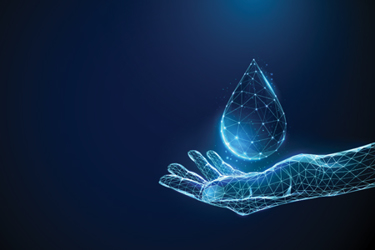How IoT Sensors Reduce Water Waste
By Marc Pégulu

To stretch water resources as scarcity intensifies, utilities and industry should lean on the latest sensing technology, enabled by the Internet of Things (IoT).
Water is vital to every aspect of our lives, and water usage has continued to increase as manufacturing and food production expand to meet the needs of a growing population. Water is a precious natural commodity and is wasted at distressing levels. In domestic settings alone, the U.S. EPA reports1 that leaks can waste nearly 1 trillion gallons of water annually. This waste has to be prevented to ensure sustainability and to reduce costs.
Data from Bluefield Research indicates that water costs are increasing faster than any other household utility, at an average of 4.2%2 per year. As water costs rise, it becomes critical to examine water usage and how waste impacts consumption costs. When leaks occur, added costs follow due to service interruptions and the labor required to fix the leak. Energy used transporting and treating water is ultimately wasted.
Routine preventative maintenance is a common way of curbing waste, but this approach creates waste of its own, as it requires replacing parts and machinery while they’re still useful. It also only accounts for preventing wear-and-tear, and may not catch issues caused by isolated incidents of damage. Equipping machinery with technology that continuously monitors performance can prevent water waste by detecting leaks and anomalies the moment they happen.
Connecting Water Systems With LPWANs
The Internet of Things (IoT) refers to equipping physical objects with sensors, providing remote visibility and control into processes that were previously analog. Whether used in manufacturing plants or in household settings, IoT sensors can be attached to multiple equipment types, including water pipelines. Once connected, sensors can detect a variety of issues, including leaks, deviations from optimal settings, and equipment malfunctions.
Sensor capability depends on the network through which they are connected. Several network options for IoT sensors are available in today’s market, each with various pros and cons. Wi-Fi or cellular networks are useful for sensors that need to transmit large amounts of data continuously, including high-bandwidth information like video. Wi-Fi networks are high bandwidth, but have short ranges, so they are typically available in household settings. However, high bandwidth requires more power. These sensors must be powered through hard-wiring, which can be expensive to install and must be installed in an easy-to-access location as they require frequent battery replacements.
Low-power, wide-area networks (LPWANs) are another popular means of connectivity, especially in use cases that benefit from a set-it-and-forget-it approach. LPWAN-connected sensors can last years on a single battery. In contrast to Wi-Fi and 5G, LPWAN sensors only transmit small amounts of information at a time, so they require a low bandwidth and a lower amount of power. This allows data to travel long distances and penetrate dense building materials. None of the data analysis is completed on the sensor itself — data are transmitted to the cloud at regular intervals.
For applications that require a regular stream of low-bandwidth information, LPWANs are a popular choice due to their lower cost and easier installation as compared to other available networks.
Big Box Stores See 20% Water Savings
Wholesale retailer Costco is a prime example of a commercial environment that realized water efficiency by implementing IoT. When the company was plagued by unnoticed water leaks, the project started as a pilot in Southern California — an arid geographic area where water preservation is critical — to reduce expensive water waste.
Costco utilized Apana,3 a water management solution that runs on an LPWAN network, to equip its retail locations with battery-powered IoT sensors. The sensors were set to measure flow and pressure through piping networks and equipment, and transmit data at one-minute intervals. This monitors process drift, mechanical malfunctions, and failure points, alerting administrators when an anomaly is detected. Once a malfunction occurs, the alert also provides issue location as well as repair instructions.
The pilot generated 22% savings in water bills, and the technology was later expanded to all of Costco’s U.S. stores.
Water Savings In Urban Settings
How might LPWAN systems support an urban environment, where data must penetrate substantial building infrastructure? In the city of Panaji, India, sensors provide smart water metering to promote efficient water use.
Panaji Municipal Corporation (PMC) utilized home water management company Cranberry Analytics4 to integrate IoT sensors into their ultrasonic water meters. These sensors enabled the availability of remote metering and consumption data, allowing PMC to diagnose issues and update its meters without physical intervention.
LPWANs’ abilities to transmit signals through dense building materials and last years on a single battery enabled a highly efficient maintenance solution for the city of Panaji.
Efficient Water Usage In Agriculture
Growing our food supply is arguably one of the most vital uses of water, and it demands more water than any other use. In fact, agriculture and horticulture account for 70%5 of freshwater usage worldwide. The amount of water each crop requires varies from plant to plant and is dependent upon location, weather, and soil type.
Farmers carefully monitor and compare myriad variables to determine when to irrigate their fields. IoT sensors can be used to measure the amount of moisture in the soil to ensure efficient water use, avoiding water waste as well as crop damage due to over- or under-watering.
As an example of IoT promoting agricultural efficiency, Sensoterra’s6 wireless sensors are built into probes, which are hammered into the ground to detect the soil moisture at varying depths. The sensors are rugged enough to last years in the field, reliably tracking moisture and temperature throughout the crop growth cycle. The technology reduces up to 30% of water usage in commercial farms.
Water monitoring in agriculture is not just a matter of efficiently growing crops. Because agriculture accounts for a significant amount of water usage, it is critical that the usage is as precise as possible to ensure sustainability.
Visibility Drives Sustainability
Whether industrial, residential, or agricultural, a real-time view into water use can dramatically improve efficiency. IoT sensors provide accurate, real-time data visibility to multiple industries in order to prevent waste and ultimately provide a return on the investment in the technology — and sustainable use of our planet’s precious water.
References:
- https://www.epa.gov/watersense/fix-leak-week
- https://www.bluefieldresearch.com/ns/up-43-over-last-decade-water-ratesrising-faster-than-other-household-utility-bills/
- https://www.apana.com/
- https://www.cranberry.tech/
- https://www.worldbank.org/en/topic/water-in-agriculture
- https://www.sensoterra.com/
About The Author
 Marc Pégulu has been Semtech’s vice president of Internet of Things for the Wireless and Sensing Products Group since 2019. Before this, he was executive vice president and general manager of the Wireless and Sensing Products Group, a position he had held since June 2015. He held the position of vice president of Wireless and Sensing Products from June 2014. Prior to this appointment, he held the position of director of marketing and applications. Mr. Pégulu joined the company in March 2006 and was involved in several key technology initiatives, including LoRa wireless and softwaredefined modem technologies. He holds a Master of Science degree in electronics and telecommunications from Institut National Polytechnique of Grenoble, France, and is a graduate of the Executive MBA program of ESCP Europe.
Marc Pégulu has been Semtech’s vice president of Internet of Things for the Wireless and Sensing Products Group since 2019. Before this, he was executive vice president and general manager of the Wireless and Sensing Products Group, a position he had held since June 2015. He held the position of vice president of Wireless and Sensing Products from June 2014. Prior to this appointment, he held the position of director of marketing and applications. Mr. Pégulu joined the company in March 2006 and was involved in several key technology initiatives, including LoRa wireless and softwaredefined modem technologies. He holds a Master of Science degree in electronics and telecommunications from Institut National Polytechnique of Grenoble, France, and is a graduate of the Executive MBA program of ESCP Europe.
